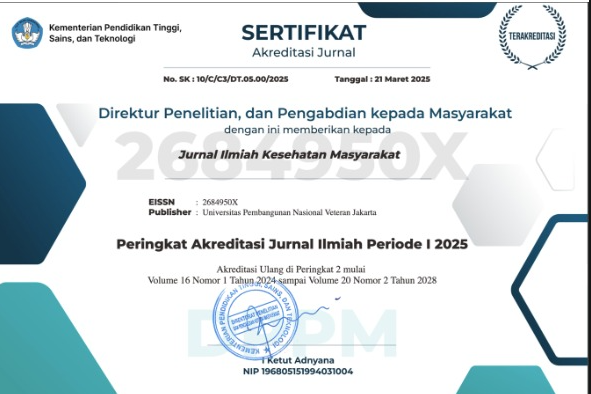Determinan Penyakit Ginjal Kronik di Tangerang Indonesia: Studi Cross-sectional
Abstract
Abstract
Latar Belakang: Penyakit ginjal kronik merupakan masalah kesehatan dunia yang sangat penting diperhatikan karena prevalensinya yang terus meningkat, dapat menurunkan tingkat produktivitas penderita, dan membutuhkan biaya pengobatan yang besar. Di Provinsi Banten terdapat 3,1 juta jiwa orang yang mengalami PGK. Tujuan penelitian ini yaitu untuk mengetahui faktor risiko kejadian penyakit ginjal kronik di RSU Kab. Tangerang.
Metode: Penelitian ini adalah penelitian analitik observasional dengan desain cross-sectional yang dilaksanakan pada bulan Januari-Februari 2022. Jenis data yang digunakan adalah data sekunder yaitu rekam medis RSU Kabupaten Tangerang. Sampel yang diambil sudah melalui inklusi dan eksklusi dengan jumlah 89 sampel dan diambil menggunakan teknik sampling total sampling. Data dianalisis dengan uji Chi Square atau Fisher serta regresi logistik biner.
Hasil: Kejadian PGK paling banyak terjadi pada usia ≥60 tahun (52,4%), sebagian besar pasien PGK tidak memiliki riwayat obesitas (54,8%), ada riwayat hipertensi (81,0%), ada riwayat DM (83,3%), dan tidak ada riwayat batu ginjal (83,3%). Risiko terjadinya PGK meningkat pada pasien yang berusia ≥60 tahun (OR=2,163; 95%CI=1,426-3,281), memiliki riwayat obesitas (OR=1,709; 95%CI=1,128-2,590), riwayat hipertensi (OR=3,798; 95%CI=1,987-7,261), riwayat diabetes melitus (OR=5,349; 95%CI=2,664-10,738), dan riwayat batu ginjal (OR=2,025; 95%CI=1,410-2,908). Diabetes melitus merupakan faktor risiko yang paling dominan memengaruhi kejadian PGK (OR=37,358; 95%CI=10,330-135,100).
Kesimpulan: Faktor risiko yang berhubungan dengan kejadian PGK adalah usia, obesitas, hipertensi, diabetes melitus, dan batu ginjal. Faktor risiko yang paling berpengaruh terhadap kejadian PGK yaitu diabetes melitus.
Kata Kunci: Faktor risiko, Penyakit ginjal kronik
Abstract
Background: Chronic kidney disease is a world health problem that is very important to pay attention to because its prevalence continues to increase, can reduce the level of productivity of sufferers, and requires large medical expenses. In Banten Province there are 3.1 million people who have CKD. The purpose of this study was to analyze the risk factors for chronic kidney disease in the Regency General Hospital. Tangerang.
Method: This research is an observational analytic study with a cross-sectional design conducted from January-February 2022. The sample is secondary data in the form of medical records. The samples taken have gone through inclusion and exclusion with a total of 89 samples and taken by total sampling. Data were analyzed by Chi Square or Fisher test and binary logistic regression.
Result: The results showed that the highest incidence of CKD occurred at age ≥60 years (52.4%), most CKD patients did not have a history of obesity (54.8%), had a history of hypertension (81.0%), had a history of DM (83.3%), and no history of kidney stones (83.3%). The risk of developing CKD increases in patients aged ≥60 years (OR=2.163; 95% CI=1.426-3.281), have a history of obesity (OR=1.709; 95% CI=1.128-2.590), history of hypertension (OR=3.798; 95 %CI=1.987-7.261), history of diabetes mellitus (PR=5.349; 95% CI=2.664-10.738), and history of kidney stones (OR=2.025; 95% CI=1.410-2.908). Diabetes mellitus is the most dominant risk factor affecting the incidence of CKD (OR=37.358; 95% CI=10.330-135.100).
Conclusion: The risk factors that associated with CKD are age, obesity, hypertension, diabetes mellitus, and kidney stones. The most influential risk factor for the incidence of CKD is diabetes mellitus.
Keywords: Chronic kidney disease, Risk factors
References
Shrestha N, Gautam S, Mishra SR, Virani SS, Dhungana RR. Burden of chronic kidney disease in the general population and high-risk groups in South Asia: A systematic review and meta-analysis. PLoS One [Internet]. 2021;16(10):1-19. Available from: http://dx.doi.org/10.1371/journal.pone.0258494.
Nusantara DTH, Irawiraman H, Devianto N. Perbandingan Kualitas Hidup Antara Pasien Penyakit Ginjal Kronik yang Menjalani Terapi CAPD dengan Hemodialisis di RSUD Abdul Wahab Sjahranie Samarinda. Jurnal Sains dan Kesehatan. 2021;3(3):365–369.
BPJS Kesehatan. INFO BPJS Edisi 104. BPJS Kesehatan. 2021;6–9.
Seli P, Harahap S. Hubungan Faktor Risiko dengan Angka Kejadian Penyakit Ginjal Kronik di RS Haji Medan pada Tahun 2020. Jurnal Kedokteran STM (Sains dan Teknologi Medik). 2021;4(2):129–136.
Sinusi R, Hargono A. Diabetes, Hypertension, Obesity, and Smoking as Risk Factor for Chronic Kidney Disease in Productive Age. Jurnal Berkala Epidemiologi. 2021;9(1):88–95.
Pralisa K, Dewi DAK, Ilmiawan MI. Gambaran etiologi penyakit ginjal kronik stadium V pada pasien rawat inap di RSUD Dokter Soedarso Pontianak tahun 2017-2018. Jurnal Cerebellum. 2020;6(3):59–65.
Kemenkes. Riset Kesehatan Dasar 2013. Kementerian Kesehatan RI. 2013.
Badan Penelitian dan Pengembangan Kesehatan RI. Laporan Nasional Riskesdas 2018. Riskesdas 2018 dalam angka, Indones [Internet]. 2018;1(1):1. Available from: https://www.kemkes.go.id/article/view/19093000001/penyakit-jantung-penyebab-kematian-terbanyak-ke-2-di-indonesia.html.
Badan Pusat Statistik. Proyeksi Penduduk Indonesia 2010–2035 [Internet]. 2018 [cited 2022 Jun 10]. Available from: https://www.bps.go.id.
Maria Y, Syarif S. Faktor-Faktor yang Berhubungan dengan Ventilator Associate Pneumonia di Ruang Intensive Care Unit Rumah Sakit Umum Kabupaten Tangerang. J Epidemiol Kesehat Indones. 2022;6(2):119–23.
Hervinda S, Novadian, Tjekyan RMS. Prevalensi dan Faktor Resiko Penyakit Gagal Ginjal Kronik di RSUP Dr. Mohammad Hoesin Palembang Tahun 2012. Majalah Kedokteran Sriwijaya. 2014;46(4):275–281.
Hirst JA, Hill N, Callaghan CAO, Lasserson D, Mcmanus RJ, Ogburn E, et al. Prevalence of chronic kidney disease in the community using data from OxRen: a UK
population-based cohort study. Br J Gen Pract. 2020;70(693):e285–e293.
Collein, I., Aminuddin, and Nurjaya. “Peningkatan Pengelolaan Diri Melalui Edukasi KADO Pada Pasien Penyakit Ginjal Stadium Awal Dan Pengaturan Pola Makan Di Wilayah Kerja Puskemas Talise. Jurnal Pengabdian Masyarakat Lentora. 2023;3(1):29-34.
Afolabi MO, Abioye-Kuteyi EA, Arogundade FA, Bello IS. Prevalence of chronic kidney disease in a Nigerian family practice population. South African Family Practice. 2009;51(2):132–137.
Yuliasari V, Aditya M, Susanto H. Evaluasi Penyesuaian Dosis Obat Pada Pasien Dengan Penyakit Ginjal Kronis Di Komunitas Indonesia Kidney Care Club (IKCC). Sainsbertek Jurnal Ilmu Sains dan Teknologi. 2021;1(2):1–8.
Badan Penelitian dan Pengembangan Kesehatan. Laporan Provinsi Banten RISKESDAS 2018. 2018;575.
Evangelista LS, Cho WK, Kim Y. Obesity and chronic kidney disease: A population-based study among South Koreans. PLoS One. 2018;13(2):1–13.
Câmara NOS, Iseki K, Kramer H, Liu ZH, Sharma K. Kidney disease and obesity: Epidemiology, mechanisms and treatment. Nat Rev Nephrol [Internet]. 2017;13(3):181–90. Available from: http://dx.doi.org/10.1038/nrneph.2016.19.
Kovesdy CP, Furth SL, Zoccali C. Obesity and Kidney Disease: Hidden Consequences of the Epidemic. Indian J Nephrol. 2017;27(2):86-92.
Joharudin A, Fitriyani L, Rofi F. Faktor-Faktor Resiko Penyakit Ginjal Kronik Studi Kasus di RSUD 45 Kuningan. PRAEPARANDI: Jurnal Farmasi dan Sains 2022;5(2):134–147.
Bahrey D, Gebremedhn G, Mariye T, Girmay A, Aberhe W, Hika A, et al. Prevalence and associated factors of chronic kidney disease among adult hypertensive patients in Tigray teaching hospitals: a cross-sectional study. BMC Res Notes [Internet]. 2019;12(1):562. Available from: https://doi.org/10.1186/s13104-019-4610-8.
Ramadhanti R, Helda. Association of Hypertension and Chronic Kidney Disease in Population Aged ≥18 Years Old. Molecular and Cellular Biomedical Sciences. 2021;5(3):137-144.
Sulistiowati E, Idaiani S. Faktor Risiko Penyakit Ginjal Kronik Berdasarkan Analisis Cross-sectional Data Awal Studi Kohort Penyakit Tidak Menular Penduduk Usia 25-65 Tahun di Kelurahan Kebon Kalapa, Kota Bogor Tahun 2011. Buletin Penelitian Kesehatan. 2015;43(3):163-172.
Adhiatma AT, Wahab Z, Widyantara IFE. Analisis Faktor-Faktor yang Berhubungan dengan Kejadian Gagal Ginjal Kronik Pada Pasien Hemodialisis Di RSUD Tugurejo Semarang. Fakultas Kedokteran Universitas Muhammadiyah Semarang [Internet]. 2017;1(1):1–10. Available from: http://repository.unimus.ac.id/id/eprint/280.
Kazancioǧlu R. Risk factors for chronic kidney disease: An update. Kidney Int Suppl. 2013;3(4):368–371.
Shang W, Li L, Ren Y, Ge Q, Ku M, Ge S, et al. History of kidney stones and risk of chronic kidney disease: A meta-analysis. PeerJ. 2017;2017(1).
Chuang TF, Hung HC, Li SF, Lee MW, Pai JY, Hung CT. Risk of chronic kidney disease in patients with kidney stones - A nationwide cohort study. BMC Nephrol. 2020;21(1):1–7.
Arifa SI, Azam M, Woro O, Handayani K. Ginjal Kronik pada Penderita Hipertensi di Indonesia. Jurnal MKMI. 2017;13(4):319–328.









.jpg)








